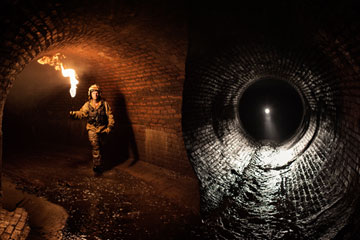
Vadim Mikhailov began exploring the secret network in the 1990s.
'Hold on, boys. I think there's a corpse down here. Looks to be dismembered." The booming voice of underground explorer Vadim Mikhailov echoes up from one of the many abandoned bomb shelters that sit hidden belowground in the center of Moscow. The series of pitch black chambers is flooded with rain from the previous night, the knee-deep water lousy with floating garbage. In a dank passageway in the shelter, Time photographer Yuri Kozyrev and I freeze in mild horror to wait for word about the corpse. Then Mikhailov shouts from deeper down, "Never mind. It's just a mannequin." It is floating facedown in the water, missing its head and torso. He waves for us to keep climbing down.
The strange pastime as a surveyor of urban netherworlds that Mikhailov has carved out for himself over the past few decades would only be possible in a city like Moscow, which has one of the world's most extensive networks of tunnels. They snake through the bedrock like a termites' nest, forming layers of hidden passageways. Starting with Ivan the Terrible, Russia's czars began building these caverns in the Middle Ages as places to store treasure and escape from invaders. The Communists continued the tradition through the Cold War, constructing massive bomb shelters — like the one in which we are standing — linked by a network of underground passages. The threat of annihilation accelerated the creation of a subterranean world that members of the Soviet elite hoped would help them survive a U.S. attack.
No one was more obsessed with the tunnels of Moscow than Joseph Stalin. At the end of World War II, with nightmares of the atomic-bomb attacks on the Japanese cities of Hiroshima and Nagasaki apparently swirling in his head, he ordered the construction of a rabbit's warren of bunkers and railways deep below street-level Moscow for use in case of a nuclear war. The result was a secret underground railway system code-named D-6, which, by the 1980s, featured three lines crisscrossing the city, according to historians, former government officials and underground explorers who have studied the system. Accessible only by senior officials and military personnel, it passed beneath the Kremlin, KGB headquarters and Defense Ministry and stretched miles from Moscow all the way to the government airport at Vnukovo as well as to nuclear bunkers and state residences on the outskirts of town. It is now closed off from the rest of the vast network of bunkers, tunnels and sewers beneath Moscow's streets; it's unknown whether the closure is for safety reasons — to prevent inquisitive urban adventurers getting lost or hurt in the tunnels — or if the government of President Vladimir Putin has found some use for Stalin's rail network.
Today the best way to see the parts of Moscow's subterranean warren that remain accessible is with the help of an explorer like Mikhailov, 48, an unemployed rescue worker. In the late 1970s, Mikhailov, the then teenage son of a train operator in Moscow's regular metro network, began snooping around belowground with his friends. Together they founded a club of explorers called Diggers of the Underground Planet and began giving tours to journalists after the Soviet Union collapsed in 1991. Some of these tours culminated in Mikhailov's emerging through a manhole in Red Square before bewildered Kremlin sentries.
Mikhailov had developed such an unparalleled knowledge of the tunnels that the state sometimes called on him for consultations, including in 2002 when Chechen terrorists took 850 hostages in a Moscow theater. With Mikhailov's help, special-forces troops were able to burst into the building through its sewers and underground passageways. (The incapacitating gas they had pumped in beforehand killed 130 hostages.)
During the official cover-up that followed, Mikhailov began giving interviews about the botched operation. "That's when the pressure began," he told me recently when we met at a sandwich shop near his Moscow apartment. Officials began publicly accusing him of exposing state secrets. He says he was interrogated by the security services and threatened with imprisonment if he continued his explorations. But he has ignored the threats and still spends hours wandering the dank, quiet world below the fast-paced capital.
You don't have to get your feet wet and dirty to see one part of Moscow's subterranean history. Bunker 42 is an underground Red Army command center that was declassified in the 1990s and turned into a museum of the Cold War. On a recent afternoon, Alexei Pavlovsky, a curator at the museum, took a local class of seventh-graders on a tour, which ended with a simulated nuclear strike against several U.S. cities. A giant screen on a wall in the bunker showed images of Americans running for cover and being incinerated in the blasts.
Afterward, over a cigarette, Pavlovsky explained that most of the secret tunnels beneath Moscow are once again inaccessible — and he puts some of the blame on amateur explorers like Mikhailov. Many Diggers boast online about how they gained entry from a sewer, say, to a bomb shelter that the state has deemed out of bounds. When the explorers return, they often find the entry points have been sealed — by the authorities, the Diggers assume. Sure enough, in the final room of the abandoned bomb shelter that Mikhailov was showing us, a metal grate blocks our way, revealing a narrow passage into the darkness. Shining his flashlight through the bars, Mikhailov apologizes, "This is as deep as we can go."
